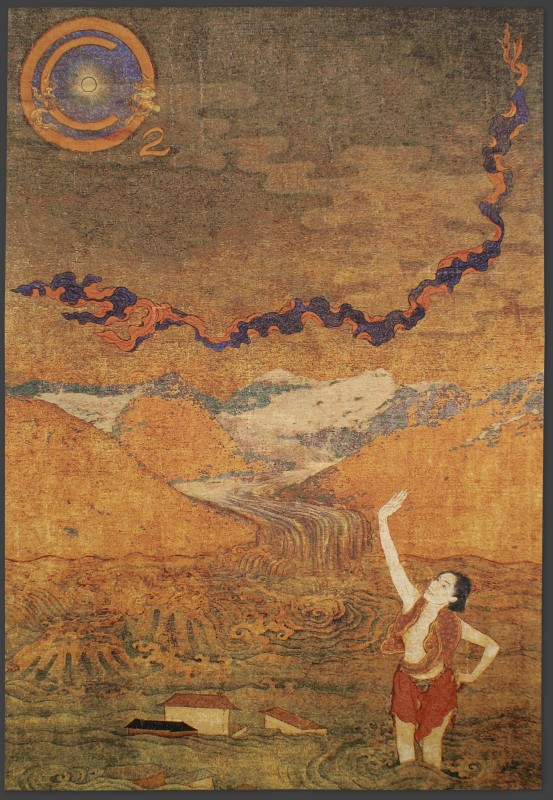
Jacquard tapestry
State I: 109 x 74 in.; State II: 72.5 x 45 in.
State I: edition of 5; State II: edition of 10
This collaborative tapestry is based on a Tibetan thangka from the late 18th century; its elements and characters have been modified and re-cast as players in a modern parable. The thangka illustrates the tale of Ghantapada, a monk who has fallen in love with a courtesan’s daughter and attained mahamudra (universal union). As the pair ascend to the sky, a flood threatens to engulf a crowd of royal courtiers hostile to their union, who are saved by the sudden appearance of the bodhisattva Avalokiteshvara.
Our tapestry employs the thangka’s iconography as a language with which to address the contemporary issue of global warming. In the thangka, the lovers’ divine union and the flood are forces beyond the control of humanity; likewise, in our time, global warming has gotten dangerously out of control. Accordingly, the threatening ‘flood’ in our tapestry is the result of melting glaciers. The sun is surrounded by a CO2 symbol, referencing the ‘greenhouse effect’ by which CO2 traps the sun’s heat in the earth’s atmosphere. Avalokiteshvara has been re-painted as an androgynous, distinctly human figure trying to halt the flood and corresponding CO2 emissions. We have replaced an animal pelt which was slung over the figure’s shoulder with a rabbit’s foot hung from his or her waist, as if to wish the figure luck in repelling danger. The lovers have vanished from a sky menaced by murky gases, in which only the floating scarf which encircled them remains. Its shape takes the form of a chart, recording the change in global temperature and rise in CO2 levels over the last thousand years.
– Donald and Era Hamaji Farnsworth
A portion of the proceeds from the sales of this edition are donated to the Tibet Fund, a nonprofit which preserves the cultural, religious and national identity of the Tibetan people, and through them the Shalu Monastery in exile and the Tibetan Children’s Village, a shelter and school for Tibetan orphans.
La tapisserie est basée sur une thangka tibétaine (œuvre d’art religieuse) de la fin du XVIIIe siècle. Les éléments qui la constituent ont été modifiés, de même que leur rôle respectif dans cette parabole moderne. Sur cette tapisserie, l’inondation est provoquée par la fonte de plusieurs glaciers. Le soleil est entouré du symbole CO2, en référence à l’accumulation de dioxyde de carbone dans l’atmosphère provoquant l’effet de serre. L’écharpe qui flotte dan l’air reproduit le graphique situé plus bas et qui montre l’évolution de la concentration en CO2 au cours de mille dernières années.
show prices
Prices and availability are subject to change without notice.The copyright of all art images belongs to the individual artists and Magnolia Editions, Inc.
©2003-2024 Magnolia Editions, Inc. All rights reserved. contact us
